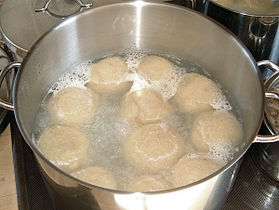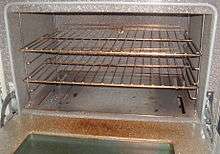Recovery time (culinary)
Recovery time is the length of time it takes a cooking medium, such as fat or water, to return to the desired cooking temperature after the food is submerged in it.[1][2] The term also pertains to the recovery time for ovens to return to their preset cooking temperature after being opened.[2]
By cooking medium
Boiling and blanching

Boiling water has a recovery time which occurs when food is added to it,[1] particularly large amounts of food. Methods to reduce recovery time are to use a larger quantity of water, cooking a lesser amount of food at a time, and using a stronger heat source.[1] Industrial and restaurant blanching equipment is susceptible to a recovery time, in which the blanching liquor requires time to reheat to its preset cooking temperature.[2]
Deep fryer
Deep fryers have a recovery time after food is cooked in them.[3][4] A faster recovery time shortens the cooking time, which lessens the amount of oil absorbed into the deep fried foods.[3] This results in a superior product compared to deep fried foods that are highly saturated with oil, and also reduces the amount of oil needed to be re-added to the deep fryer.[3][4] The use of a 1:6 ratio of food content relative to oil content has been demonstrated to minimize recovery time in deep fryers.[3]
Oven

Ovens have a recovery time after being opened.[5] Opening an oven door can reduce the temperature within an oven by up to 50° F[6] (30° C). Methods to reduce oven recovery time include the placement of a baking stone or pizza stone, tiles made of ceramic, or a brick insert device in an oven, all of which serve to reduce recovery time through their heat retention properties.[5][7]
See also
-
 Food portal
Food portal
References
- 1 2 3 Professional Garde Manger. p. 95.
- 1 2 3 International Dictionary of Food and Cooking. p. 447.
- 1 2 3 4 Breaded Fried Foods. p. 50.
- 1 2 Successful Restaurant Design. p. 150.
- 1 2 Potter, Jeff. Cooking for Geeks: Real Science, Great Hacks, and Good Food. p. 42.
- ↑ "Dwell": 67.
- ↑ Peter Reinhart's Whole Grain Breads. p. 282.